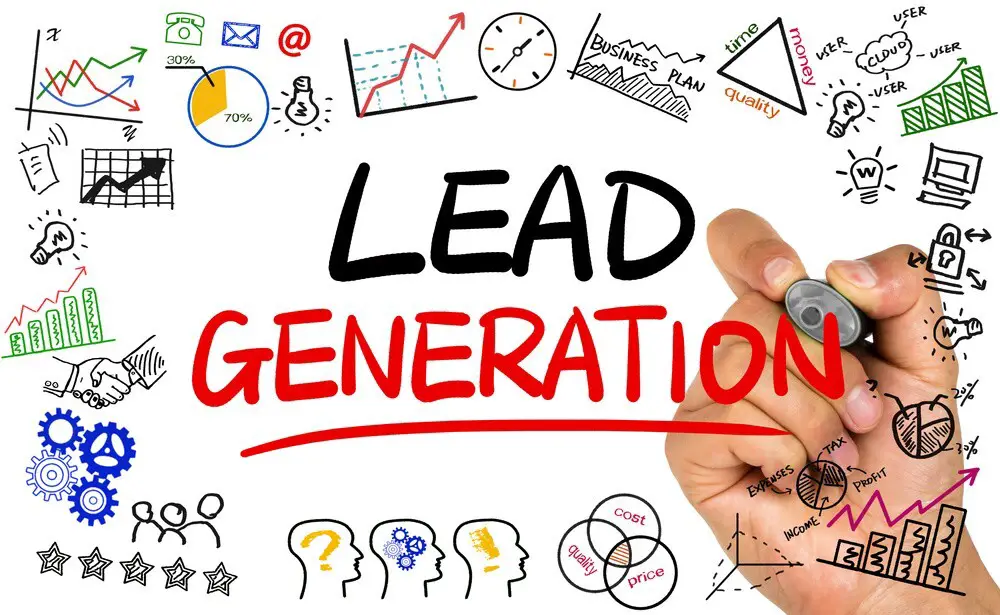

I hope you enjoy reading this blog post.
If you want my team to just do your marketing for you, click here.
Businesses and marketers alike are always seeking new ways to generate high-quality leads. But how can you know which lead generation strategies work best for your business? It comes down to trial and error, but with so many tactics out there, where do you start?
In this blog post, I’ll be sharing some of the most effective lead generation strategies, tools, and processes that have been used by small businesses over the last few years to get more leads for their business.
But first, let us acquaint ourselves with what is considered a business lead.
What Is A Business Lead?
A lead refers to the contact with a potential customer who shows a level of interest in your business. In one form or the other, this potential customer indicated an interest in what your business offers is known as a “lead.”
Depending on the organization, the interpretation of the term “lead” may vary. For example, for some businesses, a “lead” is someone that makes contact with a business to make an inquiry or partake in a freebie, while some other companies will consider a lead to be one that has made a purchase or turned into a client.
In any case, we can all agree that a lead can be considered to be a potential customer who may or may not have made a purchase. Therefore, the more leads you have, the more sales you can make. Hence, sales teams are responsible for getting a good number of leads in order to maintain a good number of sales.

My Agency can Help You Make Money Online
Cashcow Videos - we create engaging faceless cashcow and business explainer videos that earn passive income.
Monetized Blogs - select from our list of ready-made niche blogs that are already approved for monetization.
Business or Website Traffic - using various digital marketing strategies, we drive massive amounts of targeted traffic to your website.
Let’s take the point home with this example – let’s say you take an online survey to learn more about getting insurance for your car. A day later, you will receive an email from the same insurance company asking you to get insurance for your car. The process would be a lot less intrusive than if they had called or emailed you out of the blue without knowing if you would take the car insurance plan or not. That’s how it is to be a lead. You became a lead to the insurance company when you accepted to take their online survey form.
What Is Lead Generation in Digital Marketing?
So we know what a lead is, but what is lead generation all about?
Lead generation is the process of attracting and converting strangers and prospects into someone who has indicated an interest in your company’s product or service. Some examples of lead generators are job applications, blog posts with optin-forms, giving free trials & coupons, live webinars, and any online content that requires a visitor to enter their personal contact details.
Why Your Business Needs New Leads
Every business needs new leads to grow. If your business is not getting new leads every day, then it’s definitely going out of business soon.
But to drive home the importance of getting new leads, here at some points below to show you why your business needs to get more leads every day.
- The obvious reason is to increase your chances of making more sales or landing more clients.
- Your marketing and advertising will be more effective with leads since you already have a bunch of people who have shown in your business.
- You’ll have a better idea of what to offer customers if you know what moved them to show interest in your leads. This is the reason why lists are segmented in many email marketing software.
- You can measure the success of your offers by looking at how many leads you get from them. When you A/B test your lead magnets, you can measure and understand the ones your leads are more interested in.
- A higher number of leads means that people are interested in what you’re selling, which is always a good thing!
Types Of Lead Generation In Digital Marketing
In this section, we will look at the various types of lead generation in digital marketing.
There are two major types of lead generation as far as digital marketing is concerned and they are – Inbound lead generation and outbound lead generation.
#1 – Inbound Lead Generation
Inbound lead generation is a type of lead generation that tries to capture the visitor’s interest and commitment through engaging online content.
It focuses on identifying the visitors’ pain points and aims to provide a solution to their pain point through enticing and valuable content.
It involves various steps to accommodate the different stages of a buyer’s journey. Through these steps, the tailored content is served to the visitors to attract and convert them into leads.
Some of the inbound lead generation channels include blog posts and social media content and can involve written text, video, & audio content.
#2 – Outbound Lead Generation
Outbound lead generation involves the process of finding and actively engaging people that fit your Ideal Customer Profile (ICP). You don’t wait for them to come to you. Instead, you go out to find them.
How does this differ from inbound lead generation? Simply put, inbound attracts leads in, outbound goes out to find them.
Content Marketing As An Inbound Lead Generation Strategy
Most inbound lead generation strategies revolve around content marketing.
For that reason, we are going to look into what content marketing really is, how you can use it to perform inbound lead generation marketing.
Content marketing is all about planning, creating, putting out content to reach your target audience in a bid to improve your brand awareness, engagement, leads, sales, and customer loyalty.
By creating content for your target audience, you can
- Enlighten your target audience about the products and services you offer
- Increase sales and conversions
- Improve the relationship between your customers and business, which can result in increased loyalty
- Show your audience how the products and services your business renders can solve their problems.
- Create a sense of community around your brand
Now here are the various ways you can do content marketing –
#1 – Blog Content Marketing
Blogs are a powerful inbound content marketing tool, and one of the best lead generation strategies proven to be effective. It is widely used due to its use flexibility – this means that you can use it in a variety of ways which can include written articles, images, memes, videos, audio, ebooks, and many other forms of content that can actually be included in a blog.
Also, with a blog, you can promote and add social sharing buttons and have your blog posts shared by anyone on their social profile or page. This is not to mention that search engines love it. This makes it a really powerful content marketing tool indeed.
#2 – Social Media Content Marketing
There are over 3.6 billion global social media users, which makes it easy to understand why so many businesses are investing their time and resources in social media marketing.
There are quite a number of social platforms to work with, and some popular ones are – Facebook, Twitter, Instagram, Pinterest, LinkedIn. Social media marketing also has several ways you can create and share content on them, with each one having its own peculiarities.
Some kinds of content you can share on social media include images, text, videos, memes, etc.
#3 – Video Content Marketing
The rise in video content consumption has led to many marketers dedicating their time and resources to video marketing.
Research by Wyzowl says 69% of consumers prefer to learn about a brand’s product or service through video. As a result, video has proven to boost conversions, improve ROI, and help you build relationships with your audience. No wonder many sales pages now have sales videos in them.
Also, with YouTube being the 2nd largest search engine after Google, many businesses are also using YouTube to reach millions of people. As a 21st century digital marketer, you cannot neglect the power of video marketing as part of your lead generation strategies.
#4 – Infographic Content Marketing
Infographics are materials that display information in an easy-to-understand, graphic format. It usually has a mixture of text, images, charts to present a message or point in an easy to comprehend manner.
Due to its informational and easy-to-understand nature, people tend to pay more attention to it and share it on their social walls. And that is one of the reasons many marketers use infographics as part of their content marketing strategy.
#5 – Podcast Content Marketing
Podcasts are a digital audio file uploaded on a podcast software for people to listen to or download on their device and is typically available as a series.
A survey conducted in the U.S. in 2020 reveals that 49% of 12-to-32-year-olds in the U.S. had listened to a podcast within a month, with an average listening time of six hours a week. As a result, many businesses and media outlets have begun creating podcasts to gain more exposure.
Outbound Lead Generation Strategies
Outbound lead generation strategies are focused on the actions a marketer or business takes to reach out to an audience or stranger and try to convert them into a lead.
Some of the ways to perform outbound lead generation strategies are
#1 – PPC Ads and Retargeting
When you run ads either on Google, or any of the many social ad networks out there, the idea is that most times, the people you are trying to reach out to don’t know about your business before. But you target them based on their interests, keywords, location, etc., with the hope that they will most likely indicate interest in what your business has to offer.
Some popular PPC ads are Google Ads, Facebook Ads, Microsoft Ads, LinkedIn Ads, Pinterest Ads, etc.
#2 – Cold Emails
Sending out cold emails to a list you bought with the hope that someone might indicate interest in your business is another outbound marketing strategy. But, again, this is because the email addresses’ owners don’t know you since you bought it from someone.
Types Of Leads In Digital Marketing
Leads are of different types depending on how it is gotten.
For instance, a lead gotten from when a prospect calls you to make an inquiry is different from a lead made when a prospect buys a product or even tests out a product on a free trial. Therefore, the way you handle a lead depends on the type of lead it is.
So first, let’s check out the different types of lead in digital marketing.
#1 – Information Qualified Lead
This type of lead is when prospects contact the business randomly to find information. These leads will often share their contact information to obtain more information. The marketing team then gets in touch with them and shares all the information they need to motivate them to close the deal.
These leads represent the beginning of the buyer’s journey. In exchange for their personal data, such as name, email address, and location, companies should provide useful information on a topic that is relevant to their query. This type of lead is also known as a “cold Lead.”
#2 – Marketing Qualified Leads (MQL)
The Marketing Qualified Lead is a common type of sales lead. This lead is a prospect due to the marketing efforts. You might have seen a webinar or even viewed a video. This is different than the information-qualified lead because those prospects first get to know the company and then look at the information. In the case of MQL, marketing efforts attract the lead.
These leads are mostly in the middle of the sales funnel. These leads have indicated a continuing interest in a company. Prospects will often look for solutions to the problem once they have identified it. This lead is also known as a “warm lead.”
#3 – Sales Qualified Leads (SQL)
This sales lead is usually at the bottom of a sales funnel. This lead is also known as “hot leads.”
Through the hard work and efforts of the sales team or marketer, a sales qualified lead can reach the final stage of the sales funnel. It is important to take the right first step and prospect properly in order to get to the final stage. Lead generation professionals like us can help you find the right prospects to ensure qualified leads.
They express their willingness and desire to purchase.
#4 – Product Qualified Leads (PQL)
Product qualified leads (PQLs) are those who have had meaningful use of your product via a free trial or freemium program.
PQLs are therefore more likely to be customers than other leads. PQLs can be tied to meaningful value, unlike Marketing Qualified Leads. MQLs base their buying intent on random factors such as email opens, whitepaper downloads, and webpage visits.
PQLs should already have experienced value from your product before you reach them. This allows you to sell your product more easily.
#5 – Service Qualified Leads (SQL)
A service qualified lead (or SQL) is a customer that has indicated to a customer support team member that they are available for a conversation about new products and services.
Customers can get more value from service-qualified leads by helping them to see success with their company’s products and services. SQLs can lower the cost to acquire customers (CAC) and increase customer lifetime values (LTV). This is done by keeping customers longer and encouraging them to buy more products that will help them gain more value over time.
Qualifying And Scoring A Lead
To score a lead, plan and use the right strategy that will strike the right chords with your audience.
First, imagine yourself as the customer. Then, think about the ideal buyer’s journey. This will help you create a funnel that allows leads to easily move to the point where they are ready to buy.
Make use of behavioral data: Based on the behavior of your target audience, create different buyer personas. This data will give you insight into how to move certain groups of leads up the sales funnel.
Convert leads into customers easily: Make an offer based on their place in the funnel. You should take every opportunity to close the deal. Take, for example, during Holidays; people are more likely to spend more than usual. To complete the buyer journey, it’s time to create a special offer to entice them to buy as much as possible.
Lead Generation Techniques & Best Practices
Small business owners often believe that an attractive website is all they need to start getting leads. This is not really true. A lot goes into acquiring leads than just getting a website set up for you.
The beginning of online lead generation is not just about building a website for your business. It is important to consider what happens after you have launched your website.
Many lead generation techniques can be used to get the right leads for your business. We had already treated some of them when we looked at types of lead generation – inbound and outbound strategies.
But to drive the point home, we will be showing you some real specific lead generation strategies and best practices that you can apply to your marketing efforts.
8 Lead Generation Strategies Proven To Work
SEO:
Make sure your website is well-optimized for search engines. It’s best to have a blog where you can publish SEO-optimized content on a regular basis which will give your organic traffic. Also, make sure that you embed forms where visitors can easily subscribe or contact you.
Copywriting:
Make sure your web pages are well written to motivate your website visitors into taking some action on your website such as – filling a form, social media follow, starting a free trial, etc.
Use Pop-ups:
Make sure you have different channels of capturing a lead from your website, and that includes having pop-ups on your website. You can target it to appear when the user stays for a certain number of times or when he wants to exit the webpage.
PPC Advertising:
This is the fastest way to drive traffic to a landing page that is already optimized to convert leads. With PPC advertising, you bid on keywords, set up your audience, and direct the traffic to a landing page. This is one of the best lead generation strategies to get quick traffic and more leads. Use PPC advertising if your business can afford to spend on marketing.
Social Media Marketing:
The first thing to do on your social media channels is to ensure all your social profiles are well optimized with the right CTA and link to your website or, preferably, a landing page.
Then, make sure you keep your social channels up to date with interesting posts and offers from your business or niche. You can post different varieties of content – blogs, videos, memes, quotes, podcasts, ebooks, etc. And make sure you post as much clickable content as possible.
Email marketing:
Don’t forget your existing subscribers. Nurture your existing subscribers by sending them relevant content that will help them as well as offers that will get them interested in your products or services. This could be in the form of coupons, discounts, free trials, etc.
Use ChatBots:
Chatbots are a powerful tool for lead generation. They can be used to build rapport with prospects as they are always available 24/7. You can then set them up to reflect your brand’s personality, and let it function as an extension of your sales and marketing team.
Best Lead Generation Tools And Software
You can use varieties of various lead generation tools available today – including email marketing software, chatbots/CRMs, cold outreach software, social media marketing tools, opt-in tools, etc.
In fact, 65 percent of businesses claim that generating leads and traffic is their greatest marketing challenge.
But with the right tools and strategy, you will get the results you want.
The best practices for lead generation
Before you add new lead generation tools to your stack, make sure that you are following these best practices shared by top marketers:
- Understanding your business’s audience personas will help you identify your most valued contacts’ goals, pain points, and common attributes.
- Find the channels, content types, and delivery options that appeal to these people, and then focus your lead generation efforts on those that bring real results.
Here are some of the lead generation tools you will need to get the best results for your business.
- Live Chatbots for support can help collect leads on your website
- Web forms – contact or newsletter forms
- Opt-ins and pop-ups –
- Facebook Ads tools to help you gain insights on how best to target your audience.
- Marketing automation tools
- Email marketing tools
- Surveys
- Landing page creation tools
- And many more…
However, we will be specific and show you some of the best lead generation tools and software you can use to generate and manage leads for your business.
#1 – GetResponse
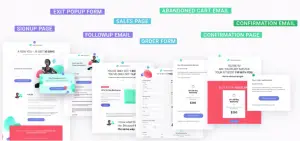
GetResponse offers more than just a basic lead generation tool. Instead, it is an automation-focused all-in-one service.
Of course, we mean all-in-one when we say it.
You can collect leads using its built-in forms, landing pages builders, and autoresponder feature.
Automation is a standout tool offered by GetResponse that’s available even in its Basic plan. And it makes it easier to create sales funnels, leads, webinars, etc.
GetResponse fully automates everything, and this makes it easy to create a sales funnel and follow up on a lead.
#2 – ConvertKit
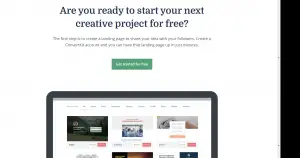
ConvertKit has been one of my favorite lead generation tools.
It is a great choice for creators of any kind. This includes bloggers, influencers, musicians, artists, and many others. Their platform is more focused on nurturing your audience with landing pages and eCommerce platforms and membership sites.
It’s possible to generate leads from casual visitors to your social media pages, blogs, YouTube videos, Facebook, and other accounts.
ConvertKit is a great option for those looking to create automated email funnels at a reasonable price.
#3 – Hubspot
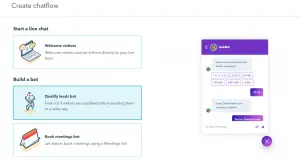
HubSpot’s live chat is a great way to communicate with website visitors. It can convert leads and help close more sales. You can also use it to support customers and assign roles to certain team members. You can, for example, direct customer inquires to the services team and then hand over leads to salespersons. It is convenient for both you and the customers.
HubSpot offers a Chatbot feature to boost your marketing further. This makes it possible to do certain tasks much more easily than you would with the “Live Chat” software.
- Meetups
- Automate and scale conversations
- Answer FAQs
- Transfer a chat to a live agent
- Support tickets can be created
- Style of human-like conversation
Both solutions are customizable and do not require programming knowledge. However, both solutions are different, and there is no better solution.
They also share many features, so it shouldn’t be hard to choose what you need. Of course, you can also choose to have the best of both. Or, you can choose to have the best of both worlds.
#4 – Snov (Cold Emailing)
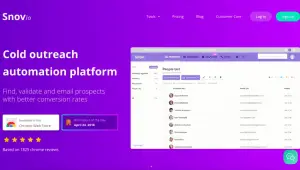
Snov, a popular software for cold emailing, has a simple interface and powerful features. Snov makes it easy to automate your email campaigns and can even help you save time. You can download the Snov extension from Google Chrome. It allows you to find an individual’s email address from a website.
Create triggers to notify you when an email is opened. Also, set up a follow-up email that will be sent when a user opens your email but doesn’t reply.
Finally, the Domain Search Tool allows you to find an email address associated with a specific domain name.
Pros
- Email Finder
- An easy-to-use interface
- Drip Campaigns
- Email Verifier that validates all email addresses
Cons
- It doesn’t feature an “Unsubscribe” link
- It doesn’t show the most used email from each contact when there are multiple email accounts
Pricing:
- Small Plan: $29 per user
- Medium Plan: $49 per user
- Large Plan: $79 per user
- Extra-Large Plans: $139 per user
Website: snov.io
#5 – LeadFeeder (Cold Emailing)
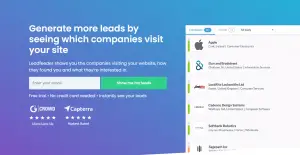
LeadFeeder offers a 2-week trial. To access all features, you will need to purchase a paid plan.
This app allows you to see who is visiting your site, what they are doing, and how you can target them. In addition, the app provides contact information to visitors, which can help increase conversion rates.
This tool is best suited for B2B companies. Leadfeeder is a complete tracking tool; it’s not wrong to say so.
It monitors who visits your website and connects to Google Analytics to provide up-to-date results.
Although the app is simple to use, it may not work well on large sites due to its slow speeds. It can also provide information about visitors who have not provided their details.
#6 – Freshchat Chat Bot (CRM)
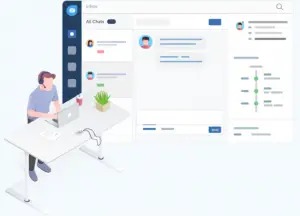
Freshchat from Freshworks allows you to engage with visitors and provide support for existing customers – no matter where they may be. To route messages to the right team, you can categorize conversations into multiple channels. In addition, their bot feature allows you to generate leads 24×7.
Let’s take the next look at the feature.
- In-app campaigns: onboard, engage and retain.
- Bot – You can easily customize the tone of your Bot’s replies with a simple editor. Use Bot to automate answering common questions.
- Segmentation is a way to make sure that not all customers fall into the same category. Segmentation – You can create segments based on product usage and geography. You can target them differently.
- FAQ – An integrated multilingual FAQ within the chat window.
Freshchat has real-time metrics that you can use to make decisions as and when necessary.
Conclusion
We have tried our best to cover what lead generation is all about and the best lead generation strategies in this article. We hope you find it resourceful. Check out our other articles for more juicy info>>>




